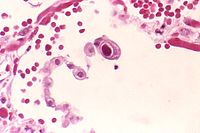
Photo from wikipedia
The United States Food and Drug Administration recently issued guidance that CMV DNAemia (quantitative CMV viral load as measured by PCR) could be used in a composite endpoint along with… Click to show full abstract
The United States Food and Drug Administration recently issued guidance that CMV DNAemia (quantitative CMV viral load as measured by PCR) could be used in a composite endpoint along with tissue-invasive CMV disease as the primary endpoint in allogeneic HCT CMV prophylaxis trials. However, the specific time points after antiviral treatment initiation at which to measure viral load and the viral load thresholds that most accurately predict clinical CMV disease have not been identified. In order to estimate the treatment effect of an antiviral agent on CMV clinical outcomes, placebo-controlled, randomized trial data with accompanying viral load measurements are needed. Unfortunately, in the modern era of PCR and early preemptive treatment, ethically, placebo-controlled, randomized trials that allow for the development of CMV disease after HCT can no longer be performed. To overcome this limitation, we performed CMV DNA PCR testing on frozen plasma samples collected during the first 100 days post-HCT in the only placebo-controlled, double-blind RCT of ganciclovir for the early treatment of CMV infection after HCT (Goodrich et al. NEJM 1991). We used three analytic methods (Cox proportional hazards models, machine learning, and a novel non-parametric method) to determine which of 14 viral load markers, measured in the first four weeks of treatment, are the most useful surrogates of antiviral treatment for the prevention of CMV disease. All methods identified peak viral load and percentage of positive samples by week 4 as highly associated with or predictive of tissue-invasive CMV disease by week 8 post-randomization. Cox proportional hazards models (Figure 1) yielded significant associations for peak viral load measured by week 4 (HR 1.4, 95% CI 1.1-1.9) and percentage of positive samples by week 4 (HR 1.6, CI 1.1-2.3). The machine-learning ensemble algorithm SuperLearner implemented in R (Figure 2) demonstrated cross-validated area under the receiver-operator curves of at least 75% for peak viral load (75%, CI 62-87%) and percentage of positive plasma samples (77%, CI 63-90%) measured by week 4. Using a novel statistical technique that allows direct estimation of biomarker surrogacy (Parast et al. Stat Med 2017), we estimated that the percentage of ganciclovir treatment effect explained by peak viral load and percentage of positive samples measured by week 4 was greater than 85%—peak viral load 89%, CI 56-100%; percent positive samples 91%, CI 60-100% (Figure 3). Peak viral load and percentage of positive samples by week 4 are highly predictive of CMV disease and the treatment effect of ganciclovir. Our analysis suggests that these may be the best surrogate markers of ganciclovir treatment and introduces novel methods for identifying optimal candidate biomarkers as surrogates for clinical endpoints.
Journal Title: Biology of Blood and Marrow Transplantation
Year Published: 2019
Link to full text (if available)
Share on Social Media: Sign Up to like & get
recommendations!